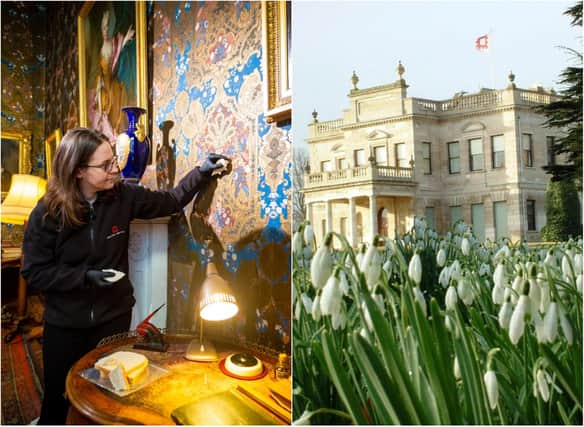Bread and milk clean-up as Doncaster's historic Brodsworth Hall prepares to re-open


The English Heritage gem is set to bounce back into business on May 17 as coronavirus lockdown restrictions are eased across the country.
And staff at the country mansion have been Spring cleaning the old-fashioned way, using a variety of weird and wonderful techniques back to have it looking spick and span for the new season.
Advertisement
Hide AdAdvertisement
Hide Ad“Historic home cleaning methods can be more effective than modern techniques,” said an English Heritage spokesman.
It comes with the release of a new video of its Victorian YouTube star Avis Crocombe revealing her top tips.
The conservation charity has been experimenting with the historic techniques of using milk on flag stone floors and using bread to remove dirt from wallpaper as part of its annual spring clean while Mrs Crocombe shows how similar methods can be used in your own kitchen.
The unusual methods are among the top historical cleaning tips revealed by the charity as it prepares to open the historic interiors at its sites around the country on 17 May. Tickets to visit can be booked on the English Heritage website now.
Advertisement
Hide AdAdvertisement
Hide AdWith no supermarket around the corner or internet shopping to cater for their every need, historic housekeepers had to be much more resourceful in their cleaning techniques; often relying on items from around the house and an array of cleaning brushes and old fashioned elbow grease.
Conservators at English Heritage have been following in their footsteps by testing different types of milk on flagstones at Brodsworth Hall.
The experiments have shown that skimmed milk could indeed be a useful cleansing agent for stone floors.
Tests with white bread have also shown that it can collect an impressive amount of dirt when used on wallpaper.
Advertisement
Hide AdAdvertisement
Hide AdMrs Crocombe, the star of English Heritage’s popular YouTube cookery series The Victorian Way and inspired by the life of the Victorian head cook of the same name at Audley End House in Essex, shows how to employ historic techniques in your kitchen at home in her new video including how to scrub frying pans with stale bread and soak pots in soda water.
Amber Xavier-Rowe, Head of Collections Conservation at English Heritage, said: “Although we may not recommend some of the more bizarre historic cleaning tips, like using a potato to clean an oil painting, housekeepers of the past were often spot on with their methods, despite relatively little scientific knowledge.
“Using white bread to clean wallpaper is a great example. We tend to use a synthetic bread to avoid attracting pests but the idea is the same and normal bread works just as well.
"Just don’t forget to hoover the crumbs!”
Though they were often on the right track, housekeepers of the past’s more unusual cleaning methods might leave you scratching your head.
Advertisement
Hide AdAdvertisement
Hide AdEnglish Heritage’s conservators have compiled a list of historic cleaning tips that you should definitely NOT employ this spring, including using a potato to clean an oil painting, and Worcestershire sauce to polish silver.
Historic cleaning tips you could still use:
Use bread to clean wallpaper (but remember to clean up the crumbs!)
Use skimmed milk on stone flagstone floors, but test in a small area first
Rejuventate your waxed timber floor with a mixture of beeswax and turpentine
Advertisement
Hide AdAdvertisement
Hide AdUse a pony haired brush to dust your furniture and figurines
Use a soft chamois leather to give a shine to mirrors. This is much better and eco-friendly than glass cleaners
Brush and polish your fire grate with a fire blacking product to prevent corrosion
Historic cleaning tips you should ignore as likely to do more harm then good:
Sprinkle your carpet with damp tea leaves before sweeping
Advertisement
Hide AdAdvertisement
Hide AdTo clean your oil paintings, rub a freshly cut slice of potato damped in cold water over the picture. Wipe off the lather with a damp sponge, and finish with lukewarm water and dry and polish with an old silk handkerchief
To clean wallpaper, apply oatmeal over whole surface of the wall with a piece of flannel and sweep down with a soft broom or feather duster
To clean mould from paintings, leave them in direct sunlight to sunbathe
Bring silver to a shine using salt and Worcester sauce
Washing oat floor boards with beer
Using salt and lemon on historic copper pans
Routine was key to keeping on top of the house work with strict daily, weekly and fortnightly cleaning tasks.
Advertisement
Hide AdAdvertisement
Hide AdAs well as extensive cleaning throughout the year, English Heritage has used the winter closure of properties to carry out a top to bottom clean.
This annual spring clean is a major job and English Heritage’s conservation experts have been busy lifting and rolling carpets, dusting books on shelves, cleaning silver and copper and washing chandeliers to prepare for the opening of the historic interiors at English Heritage sites on 17 May.
Tickets can be pre-booked for the summer here: https://www.english-heritage.org.uk/visit/plan-your-visit/
Watch Avis Crocombe’s Victorian Cleaning video HERE